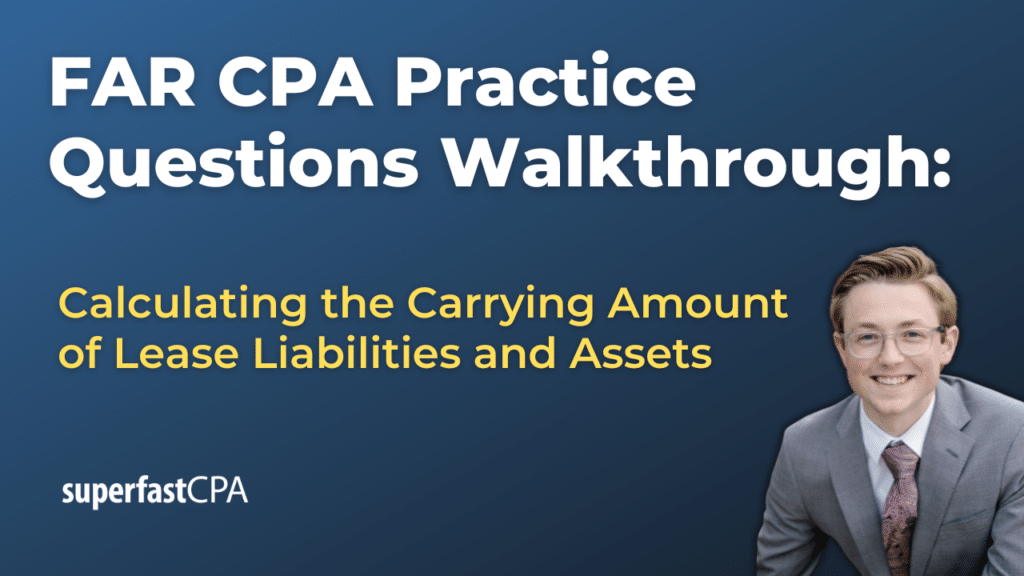In this video, we walk through 5 FAR practice questions about the lease classification criteria. These questions are from FAR content area 3 on the AICPA CPA exam blueprints: Select Transactions.
The best way to use this video is to pause each time we get to a new question in the video, and then make your own attempt at the question before watching us go through it.
Also be sure to watch one of our free webinars on the 6 “key ingredients” to an extremely effective & efficient CPA study process here…
Calculating the Carrying Amount of Lease Liabilities and Assets
Leases are a cornerstone of financial reporting, and calculating the carrying amounts of lease-related assets and liabilities is a key requirement under accounting standards like ASC 842. This guide provides a detailed explanation, step-by-step instructions, and practical examples to help you navigate this process.
1. Initial Measurement of Lease Liability
The lease liability represents the present value of future lease payments, discounted using the appropriate interest rate.
Key Considerations:
- Interest Rate: Use the implicit rate if it is known and lower than the lessee’s incremental borrowing rate. Otherwise, use the lessee’s incremental borrowing rate.
- Lease Payments: Include fixed payments, variable payments tied to an index or rate, and any amounts expected to be paid under residual value guarantees.
Example:
Scenario: A lessee signs a 5-year lease for equipment with annual payments of $25,000, paid at the beginning of each year. The implicit rate is 5%, and the present value of an annuity due factor for 5 years at 5% is 4.546.
Calculation: Lease liability = $25,000 × 4.546 = $113,650
2. Measurement of the Right-of-Use (ROU) Asset
The ROU asset is initially measured as the lease liability, adjusted for prepayments, direct costs, and lease incentives.
Adjustments:
- Add: Any direct costs (e.g., legal or advisory fees) and prepayments made before lease commencement.
- Subtract: Lease incentives received.
Example:
Scenario: Using the lease liability of $113,650 from the previous example, assume the lessee incurred $3,000 in legal fees and received no incentives.
Calculation: ROU asset = Lease liability + Direct costs = $113,650 + $3,000 = $116,650
Journal Entry at Lease Commencement:
Debit: Right-of-Use Asset $116,650
Credit: Lease Liability $113,650
Credit: Cash $3,000
3. Subsequent Measurement of the Lease Liability
The lease liability decreases with each payment, with a portion allocated to interest and the remainder reducing the principal. Interest is calculated using the effective interest method.
Example:
Scenario: In the above lease, the first payment of $25,000 is made immediately, reducing the principal. At the end of Year 1, interest is calculated as follows:
- Beginning lease liability after first payment = $113,650 – $25,000 = $88,650
- Interest for Year 1 = $88,650 × 5% = $4,433
Journal Entry for Year 1 Payment:
Debit: Interest Expense $4,433
Debit: Lease Liability $20,567
Credit: Cash $25,000
New lease liability at the end of Year 1 = $88,650 – $20,567 = $68,083
4. Amortization of the ROU Asset
The ROU asset is amortized on a straight-line basis unless another method better reflects the asset’s usage. For finance leases, the amortization period depends on the asset’s ownership terms:
- Useful Life: If ownership transfers or there is a bargain purchase option.
- Lease Term: If ownership does not transfer and there is no bargain purchase option.
Example:
Scenario: The ROU asset of $116,650 is amortized over the 5-year lease term because ownership does not transfer, and there is no bargain purchase option.
- Annual amortization = $116,650 ÷ 5 = $23,330
Journal Entry for Amortization (Year 1 and Year 2):
Debit: Amortization Expense $23,330
Credit: Right-of-Use Asset $23,330
Carrying amount of the ROU asset at the end of Year 2:
Initial ROU asset ($116,650) – Accumulated amortization (2 × $23,330) = $70,990













